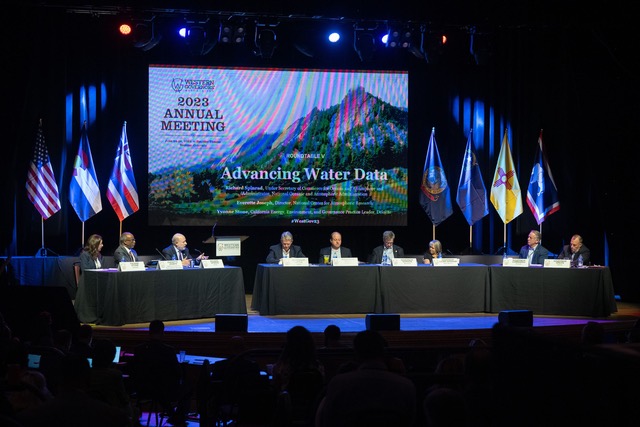The use of artificial intelligence is creating vast improvements in data processing and forecasts that will give Western states the tools they need to better manage their scarce water supplies, according to Richard Spinrad, administrator of the National Oceanic and Atmospheric Administration (NOAA).
“Machine learning and deep learning are actually the places where I think we’re going to see extraordinary improvements,” Spinrad said at a meeting of the Western Governors’ Association in Boulder last week.
AI refers to computer systems that perform tasks that normally require human intelligence, while machine learning is a form of AI that focuses on the use of data and algorithms to imitate the way humans learn, gradually improving accuracy, according to the Oxford Dictionary.
Spinrad credited the Bipartisan Infrastructure Law of 2021 with giving the National Weather Service, an agency housed within NOAA, the resources it needs to develop a new Hydrologic Ensemble Forecast System that will provide highly accurate forecasts for more than 3,000 locations across the nation.
“Governors need actionable information, especially in times of crisis,” he said. “It is critical to have credible, reliable, actionable information. And at NOAA, we take that responsibility extremely seriously. We’re doing it for the needs of today and tomorrow, but also in terms of infrastructure development, we are working to develop the projections 10, 20 and 50 years out as well.”
Big breakthroughs that allow super-fast processing of large sets of data, satellite-based monitoring, as well as models that can precisely predict landslides and summer monsoons should vastly improve the ability of weather and water agencies to manage their supplies better and respond to emergencies faster.
At the National Center for Atmospheric Research (NCAR) there has been a push to increase the presence of weather radars, including in Colorado’s Rio Grande River Basin. Everette Joseph, director of NCAR, said work already has significantly improved forecasts.
Working with the U.S. Bureau of Reclamation, NCAR has improved its techniques for forecasting summer monsoons, which can produce 60% to 80% of total annual precipitation in the desert Southwest.
The scientists emphasized that much of their work in delivering models is focused on helping the states understand the risks and uncertainties in managing water.
And that means getting data faster and using it to make decisions and develop policies faster as well, according to Yvonne Stone, a senior manager at Deloitte, an accounting and consulting firm.
“Quicker, faster, better, more connected,” she said, in describing advances in data collection and management. But for it to be useful, it must be curated and analyzed in a way that provides a framework for making a decision. Once that policy decision is made, then outcome needs to be measured. Did it produce the expected results? That, in turn, means the need for more data.
“The problem is that there’s a fundamental tension between data and policy decisions. Water data is extremely complex and nuanced. Even just to understand the amount of water. Are you talking the flow? Are you talking the melt? How much of that was absorbed into the soil? What was the soil moisture content? How much of evapotranspiration happened? It’s enormously complex,” she said.
But on policy, it all boils down to a decision, a yes or no. “Are we going to curtail this year? Who are we going curtail? What thresholds are we going to set for groundwater pumping? What’s an acceptable level of nutrients in water or temperature for water discharge? And so it requires a lot of work to connect those pieces, to connect analysis through data policy decisions and study the outcomes to see whether they’re on track or not,” Stone said.
Correction: This article has been updated to correct the spelling of NOAA Director Richard Spinrad’s last name.
Fresh Water News is an independent, nonpartisan news initiative of Water Education Colorado. WEco is funded by multiple donors. Our editorial policy and donor list can be viewed at wateredco.org.


 Print
Print